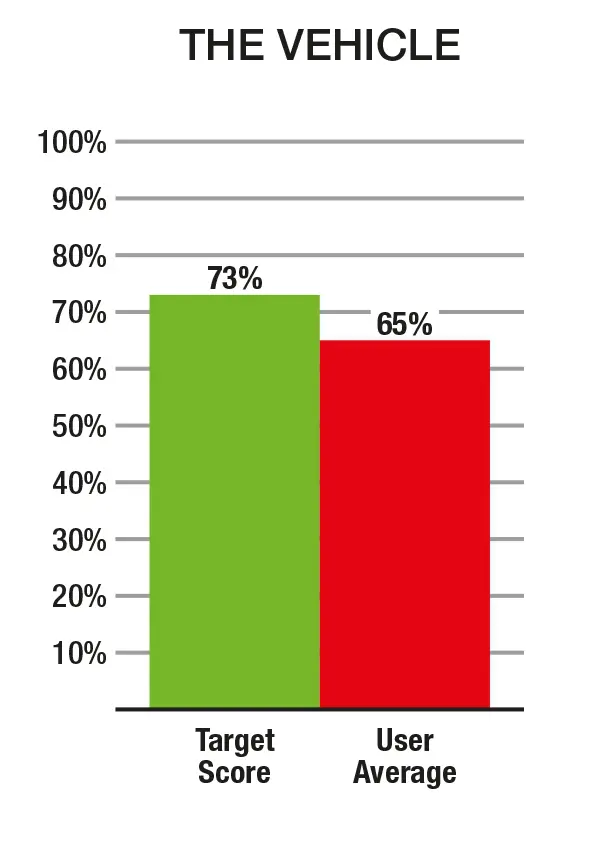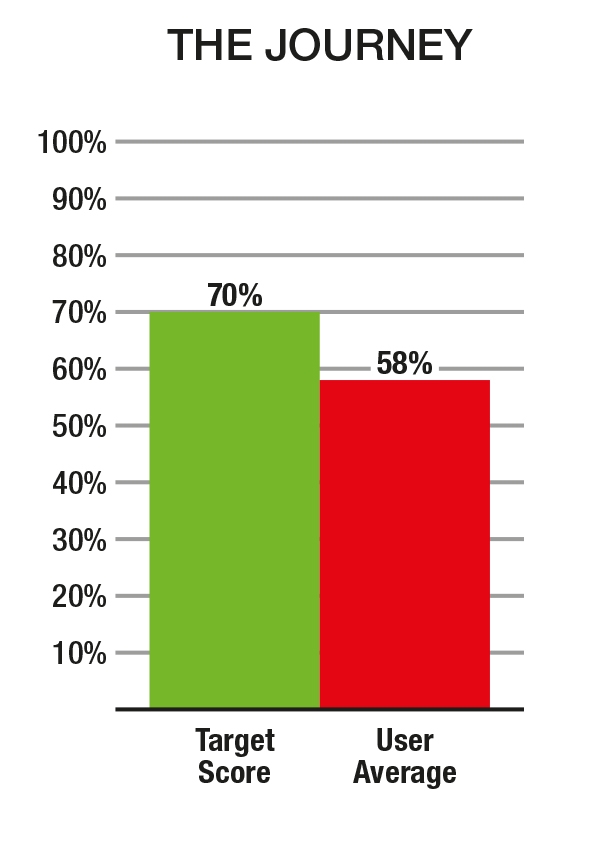Benchmarking your performance
Improving how we do anything in life can be very difficult without appropriate inspiration and guidance from a range of sources. Whether we’re trying to improve our fitness and skills to be better at sport, learning to play a musical instrument, or impressing the family with our culinary skills, we all need help to understand where we need to improve the most.
Inspiration is important because it opens our minds to what is possible – we yearn to perform at the same level as those that have so impressed us with their commitment and their success. Guidance is then essential because, if we want to emulate them, we need to know how they did it so we can replicate their journey for ourselves.
When we’re on that journey, we need to constantly check our progress to keep us on track and see how our efforts compare to those we’re trying to emulate. We are all probably constantly doing this in many small ways. Can we play a guitar or piano over our favourite song and sound like part of the band? How does our latest effort at climbing Box Hill compare with other cyclists on Strava? Does the evening dinner we’ve served up to our family match the picture in Nigella’s latest cookbook?
This is the essence of benchmarking your fleet – the process of comparing our performance with that of others to see where we stand, and we can use it to improve how we manage our fleets. Are we performing well and satisfied with where we are currently? Are we about average? Or are we lagging behind and needing to make improvements in order to catch up with our peers.
Managing road risk effectively
In fleet safety and risk management it can be especially helpful. We hear constant stories of how some companies have reduced incident rates and others have improved fuel efficiency, and that those applying best practice in managing road risk can demonstrate massive reductions in operating costs as a result. Running a fleet can be one of the most expensive operational costs in a business so the possibility of such savings can have a material effect on the company’s performance overall.
So what are the companies with the biggest gains doing better than anyone else? What do their policies look like? How are they managing their drivers and vehicles in order to bring down their operational costs.
Benchmarking your fleet – where are you now?
This is the first article in a series we will be running throughout 2019 to help fleets benchmark themselves against others so they can improve their performance. To start, we’re going to look at broad levels of risk management and where the average company sits.
A good place to start is the Driving for Better Business online fleet risk assessment. It is free to complete and you’ll get a comprehensive report at the end to show how your answers compare with the averages of around 500 other fleets that have already completed it.
If you employ 5 or more people, under the Management of Health and Safety at Work Regulations 1999, you are required to make written risk assessments of how your business activities could impact employees and others. The Health and Safety Executive is very clear that this legislation extends to work-related driving, as cars and vans used for business are now legally considered to be an extension of the work place. Even if you employ less than 5 people you still have a legal duty of care to ensure that your firm’s driving activities don’t put drivers or other road users at risk.
Developed in conjunction with FleetCheck and the FTA’s Van Excellence programme, it is ideal for fleets that are largely focused on company cars, grey fleet and light commercial vehicles. Some of the questions are based around legal compliance and use the Health and Safety Executive’s guidance on Driving for Work as the basis for what all companies should be doing as a minimum.
Then there are questions around good practice that, while they may not be legal requirements, are policies or activities that many successful fleets rely on to deliver a high level of performance and risk management. The beauty of this is that you don’t need to score 100% to demonstrate compliance, but the gaps highlight the types of activity that the best-run fleets will be implementing.

COMMON FAILING
The failure to keep adequate records of fleet activity and driver behaviour. This means the issue isn’t being managed properly, Directors aren’t aware of the true business costs, and what should be worrying trends don’t get identified and corrected.

COMMON FAILING
Surprisingly, many employers often don’t accurately know how many staff drive for them, especially if they have a large grey fleet. Another common failing is an insufficient process before handing the keys over – is your driver eligible and competent and have they seen your Driving for Work policy?

COMMON FAILING
While many employers think vehicle checks are being done properly they often aren’t, and employers also need to ensure any staff using their own car for work journeys have insured it for business use.

COMMON FAILING
Few companies, especially smaller ones, account for commuting time on top of work driving meaning some drivers could have been out for 12 hours, 15 hours or even longer by the time they get home. An overnight stay policy is also a must for those whose drivers travel further afield.
The first section covers the company and starts to build a picture of your fleet, looking at the operational policies and processes you currently have in place. In order for a company to be meetings its legal obligations for risk management it should really be scoring around 85-90% in this section yet the average score is just 64% implying that many businesses are not managing their fleet risk as well as they need to.
Two of these important questions relate to recording fleet activity and monitoring driver performance. As this issue of Fleet News is focusing on ‘Fleet Software’ it would be prudent to ensure the capabilities and benefits of these systems are fully understood as they can contribute enormously to any improvements you might want or need to make. Fleet Managers need to have a robust way of identifying trends – especially ones that indicate rising costs or accident rates – and then tracking the effectiveness of any corrective action. If it isn’t measured, it can’t be improved.
A key element of this section relates to the company’s Driving for Work policy and what rules it sets out for drivers. This can be a common anxiety for directors and fleet managers who want to know if their policy is up to scratch and what a good policy looks like. The Driving for Better Business website contains example policies and driver handbooks from some of our Business Champions such as Arval, McLaren Automotive, Amey and Gateshead Council so that you can see how others deal with similar issues and use them to improve your own.
Fleet software is also vital to help reduce the time and resource needed to keep on top of the issues in the three remaining sections of our risk assessment.
In the section on managing Drivers, the focus is on ensuring you have all the information you need about the people you ask to drive on your behalf including their health and driving record, and the level of risk they are exposed to. Again, we see the average score of 60% lagging someway behind what should be a minimum acceptable level of around 75-80%.
Management of vehicles is another important subject as poor checking and maintenance regimes can significantly increase both the costs to the business and the risk that one of your vehicles could be at the centre of a serious crash. The average user score here is 66% and is much closer to the required level of around 70-75% but this leaves a lot of room for fleet managers to pursue good practice and see some significant benefits they wouldn’t otherwise achieve.
The last section – assessing the risk associated with journeys – highlights the lowest average user score at 58% however, as with vehicles, fleets should be aiming to hit 70-75% here so there are a lot of businesses not reaching the level of journey risk management they really should be achieving.
Overall this means fleets are, on average, achieving an overall score of 62% when they should really be hitting 75-80%. While this isn’t a complete disaster, it does illustrate that many fleets have some way to go to fully manage their risks. What is of concern however is that this is an average only – so some of those companies are likely to be falling worryingly short of where they need to be.
If you’d like to see where you currently sit with regards to general fleet risk management, then please take a look at our online gap analysis tool for fleet managers and those who employ drivers, which will give you a clear idea of the main risk issues fleet managers should be addressing.
Over the coming months, we’ll be looking at specific issues where benchmarking can prove really beneficial, such as policies on driver distraction, use of telematics, emission levels and vehicle safety in much greater detail, to see what good practice looks like and what benefits the best performing companies are achieving.
One of the most common areas where companies fall below required standards is the failure to keep adequate records of fleet activity and driver behaviour. This means the issue isn’t being managed properly, Directors aren’t aware of the true business costs, and what should be worrying trends don’t get identified and corrected.







